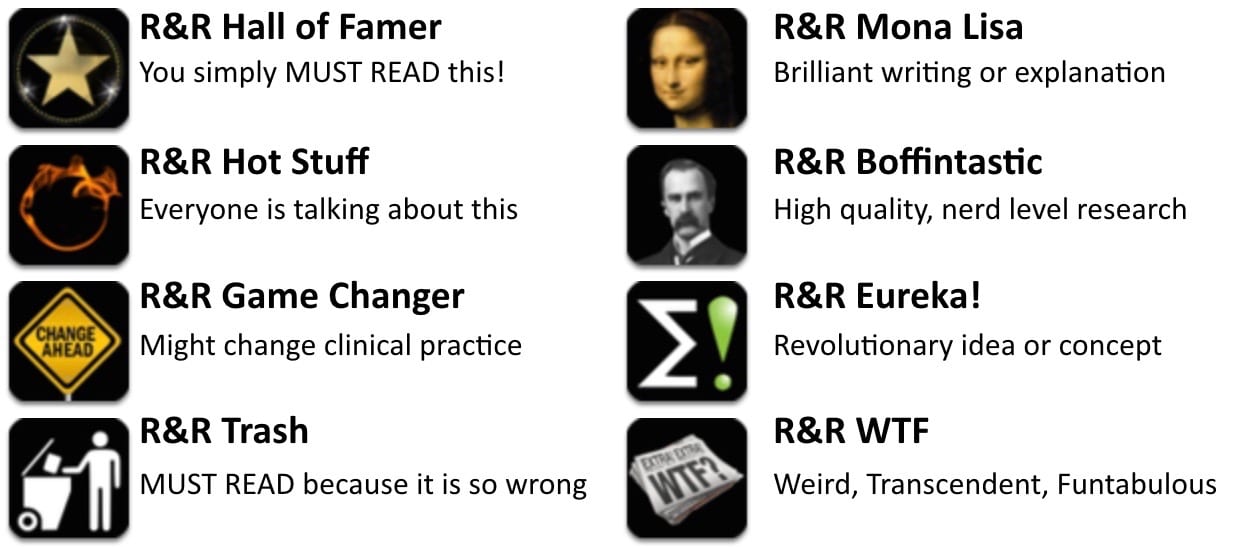R&R In The FASTLANE 187
Welcome to the 187th edition of Research and Reviews in the Fastlane. R&R in the Fastlane is a free resource that harnesses the power of social media to allow some of the best and brightest emergency medicine and critical care clinicians from all over the world tell us what they think is worth reading from the published literature.
This edition contains 5 recommended reads. The R&R Editorial Team includes Jeremy Fried, Nudrat Rashid, Soren Rudolph, Anand Swaminathan and, of course, Chris Nickson. Find more R&R in the Fastlane reviews in the : Overview; Archives and Contributors
This Edition’s R&R Hall of Famer
Okumura T, Suzuki K, Fukuda A. The Tokyo subway sarin attack: disaster management, Part 1: Community emergency response. Academic emergency medicine. 1998; 5(6):613-7. PMID: 9660289
- This is the first of 2 papers published in the same journal documenting the experience in Japan after the Tokyo subway sarin attack in 1995. I think they are must reads for any emergency provider, because they raise some incredibly important questions about disaster preparedness.
- Recommended by: Justin Morgenstern
Sinert R et al. Randomized Trial of Icatibant for Angiotensin-Converting Enzyme Inhibitor Induced Upper Airway Angioedema. J Allergy Clin Immunol Pract 2017. PMID: 28552382
- Swami: Is there a role for Icatibant in the treatment of ACE Inhibitor induced angioedema? A 2015 small trial in NEJM brought this treatment into the forefront but the study was terribly flawed and tiny. Now, we have a superior study to answer the question. In this multinational, randomized, double-blind, placebo-controlled trial, there was no benefit in time to resolution of moderate to severe angioedema with Icatibant versus standard care only. For now, angioedema will remain a matter of controlling the airway when necessary and waiting and watching.
- Radecki: Icatibant is only USD$9600 per dose – and couldn’t demonstrate any utility in this sponsored, randomized-controlled trial for upper airway angioedema.
- Recommended by: Anand Swaminathan and Ryan Radecki
Cohen C et al. Protocol for Reducing Time to Antibiotics in Pediatric Patients Presenting to an Emergency Department With Fever and Neutropenia: Efficacy and Barriers. Pediatr Emerg Care. 2016 Nov;32(11):739-745. PMID: 25822237
- Neutropenic Fever can be a challenging condition to manage as the patient may appear deceptively well until she/he is critically ill. Due to this known issue, many have advocated for developing protocols to help expedite the care of patients who are at risk for being neutropenic and febrile. This study discusses some of the potential strategies.
- Recommended by: Sean M. Fox
Andersen LW et al. Association Between Tracheal Intubation During Adult In-Hospital Cardiac Arrest and Survival. JAMA. 2017; 317(5):494-506. PMID: 28118660
- This is a retrospective cohort study based on data collected prospectively for the get with the guidelines resuscitation registry. There were 143,810 adult patients from 668 US hospitals, but 35,731 had missing data, so 108,079 were included in the final analysis. Among patients with in-hospital cardiac arrest, they compared patients successfully intubated in the first 15 minutes to those who were not. They matched patients 1 to 1 based on propensity matching. Of course, we can’t know the physicians’ thinking during the arrest, and the many reasons that patients may or may not be intubated are the confounders that make this data unreliable. For the primary outcome of survival to hospital discharge, the intubation group did worse in both the unadjusted (33.2% vs. 17%, RR 0.58; 95% CI 0.57-0.59) and adjusted analyses (19.4% vs. 16.3%, RR 0.84 95% CI 0.81-0.87). Return of spontaneous circulation and neurologic function were also worse in the intubated group. Although the observational nature of this data means it shouldn’t immediately change practice, I think it fits with what we know about airway management in cardiac arrest. We have over-emphasized the importance of airway management for a long time.
- Recommended by: Justin Morgenstern
Davis AJ et al. Practical Application of Educational Theory for Learning Technical Skills in Emergency Medicine. Ann Emerg Med 2017.
- This article is a thoughtful discussion about how traditional education resources as well as innovative approaches (i.e. FOAM) can be integrated in learning and teaching procedural skills in Emergency Medicine. A nice read with specific ideas for those working with trainees.
- Recommended by: Anand Swaminathan
Community emergency physician with a passion for education, evidence based medicine, and life, working in the Greater Toronto Area (that’s in Canada) | @First10EM | Website |





